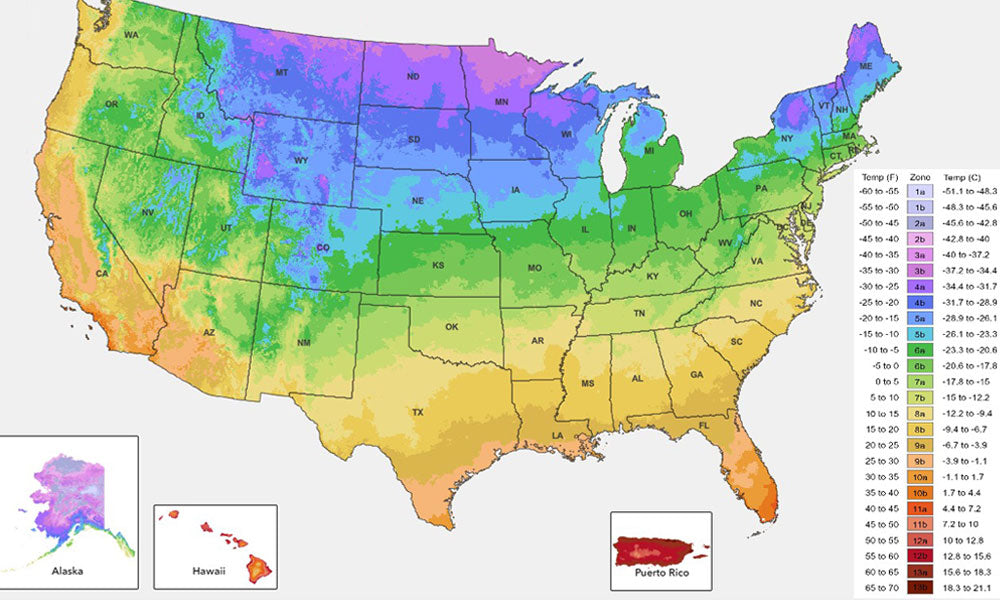If you are passionate about growing plants, you've probably heard about the recent update to the USDA Grow Zone Map. In this blog post, we'll dive into the exciting improvements in the new map and answer common questions surrounding planting zones so you can create a thriving, flourishing garden!
USDA Grow Zone Map
The USDA Grow Zone Map is like our gardening compass, guiding us through the diverse climates across the United States. It's the go-to standard for gardeners and growers. This map determines which perennial plants are most likely to thrive at a specific location.
The USDA Plant Hardiness Zone Map was just updated in November of 2023. It was jointly developed by USDA's Agricultural Research Service (ARS) and Oregon State University's (OSU) PRISM Climate Group. The latest update brings more accuracy and contains even more detail, reflecting the ever-changing climate patterns. It is based on the average annual extreme minimum winter temperature displayed as 10-degree F zones and 5-degree F half zones.
According to the USDA, the new 2023 map uses data from 13,412 weather stations. The previous map only used 7,983 weather stations. The 2023 version shows that half of the country moved up to a warmer zone while the other half stayed in the same zone. Scientists are using 30 years of long-range data and more sophisticated computers for a more accurate map. This data was especially improved for areas such as mountain zones and Alaska where they may have been rated too cold or warm in prior maps.

What Planting Zones Am I In?
Planting zones are incredibly helpful to gardeners growing perennial plants since perennials are meant to live for many growing seasons. It's important that your perennial plants are hardy enough to survive the winter in your area. Winter damage occurs the most when plants are planted out of their range. If you take a look at the map, you will see a scale. The 1-13 categorizes every location in the United States by its coldest average temperature of the year.
- The coldest regions are a 1 on the scale.
- The hottest regions are 13.
- The scale is further divided by temperature. For example, 1a is colder than 1b and 2a is colder than 2b.
Note: Zone Numbers do not represent the coldest it has ever or will be in an area. It is simply the average lowest winter temperature for a given location in a 30-year span. Other factors can contribute to the success or failure of plants. These factors include wind, soil type, soil moisture, humidity, pollution, snow, and winter sunshine. The position plants are placed in the landscape, how they are planted, and their size and health can also influence their success.
Additional factors that influence the survival of plants:
- Light- Plants need to be planted where they will receive the proper amount of light.
- Soil moisture- Plants have different requirements for soil moisture. This may vary seasonally.
- Temperature- Plants grow best within a range of temperatures, both hot and cold. This range will vary depending on the variety.
- Duration of exposure to cold- Many plants can survive a short period of time exposed to the cold, while other varieties may tolerate longer periods of cold temperatures.
- Humidity- High humidity levels can limit damage from the cold weather reducing moisture loss from leaves, branches, and buds.
It is crucial that you thoughtfully select plants for your grow zone. If you are in a colder grow zone, we recommend looking for crops with shorter days to harvest to maximize your yields before frost. Or, be sure to start crops with longer days to harvest indoors so they will have enough time to produce.
What are Microclimates?
Microclimates are intricate climate variations in a relatively small area. For example, they could be small heat islands that can result from blacktop or concrete. They may also be cool spots often referred to as "frost pockets". The cool spots can be caused by small hills and valleys. The hardiness zone map may not account for microclimates. The level of knowledge that comes from gardeners learning about their gardens through hands-on experience is incredibly valuable. Identifying your unique growing conditions is an important step to selecting the plants you want to grow.
Steps to identify your grow conditions:
- First, identify where you want to plant.
- Analyze how much sunlight that location gets in a day. Does the location get full shade, part shade/part sun, or full sun?
- Determine how dry or wet the location is.
- Now you can narrow down the plant selection.
Additional Growing Tips from Pepper Joe's
We know gardening can be tricky at times. At Pepper Joe's, we work to provide you with as much helpful content that helps you grow the most optimal hot peppers. Browse through our Grow With Joe video series for more information, and be sure to check out our Gardening Tips & Guides that help break down many different pepper growing topics.
Our team of growing experts are here to help you answer any questions you have on growing hot peppers. Feel free to reach out via email or call us at (888) 660-2276 today.

